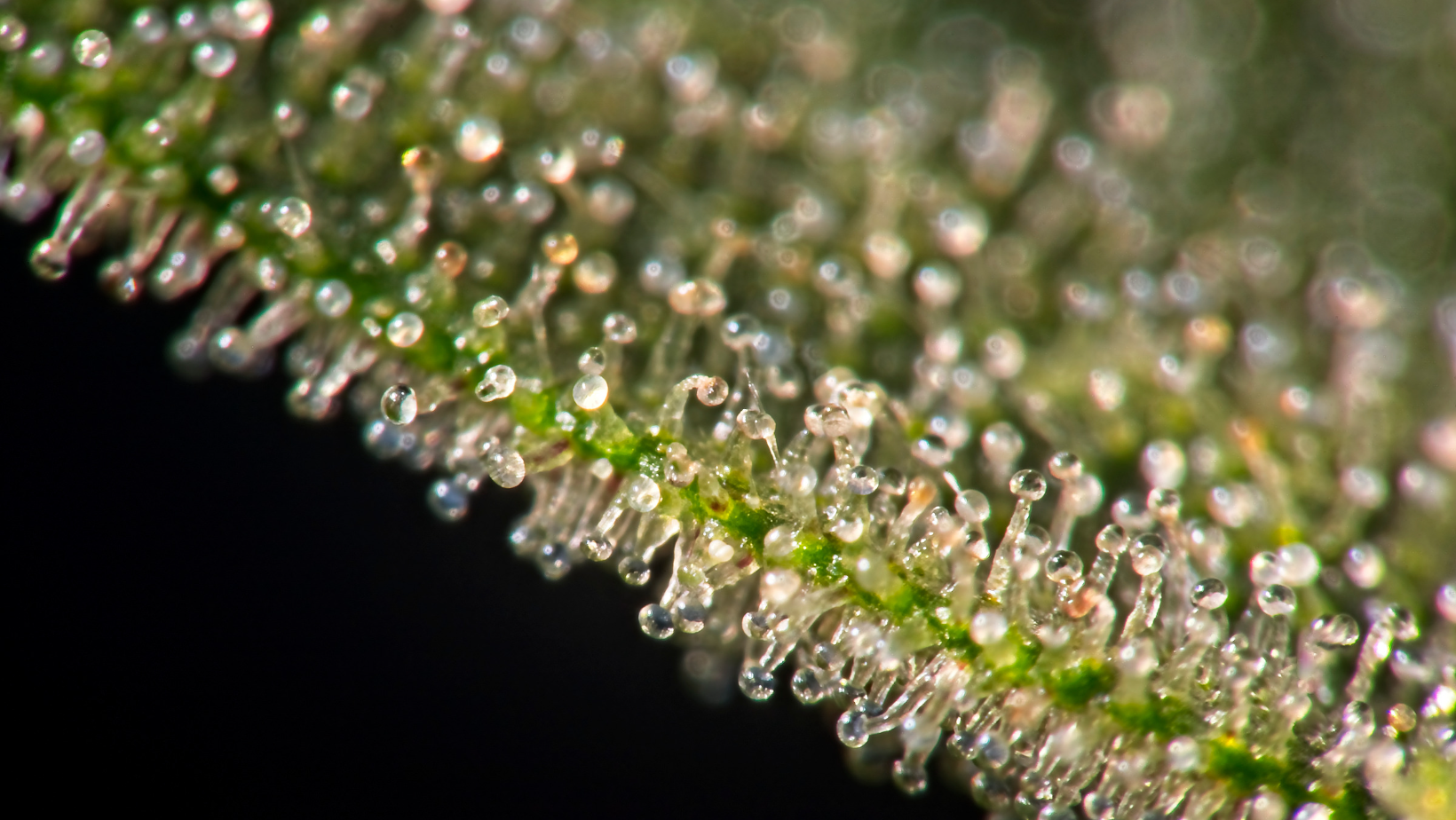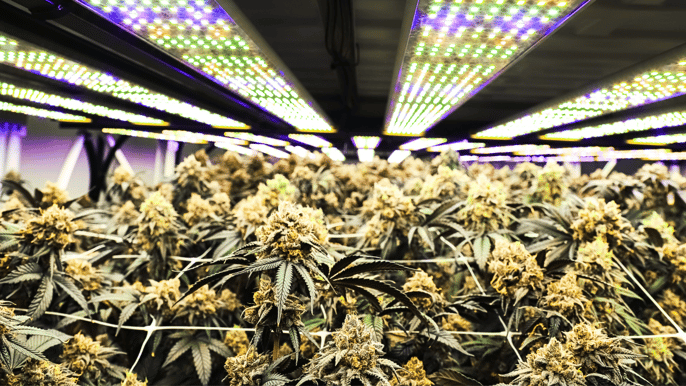Cannabis Science: Introduction to the Plant's Biology & Chemistry

Cannabis, popularly known as marijuana, has been utilized for therapeutic and recreational purposes for thousands of years. Due to its potential health benefits and the growing trend toward legalization, the plant has recently attracted more and more attention.
It is essential to have a fundamental understanding of cannabis biology and chemistry in order to comprehend its effects and qualities. In this blog post, we’ll provide an introduction to the science of cannabis, including the plant's structure, physiology, and chemical composition, as well as the function of mycelium in nutrient intake and how DLI relates to cannabis growth.
Basic Anatomy of the Cannabis Plant

- Leaves: Cannabis leaves are compound and generally have serrated edges. They can vary in size and shape, with some strains having larger leaves while others have smaller, more finely divided leaves. The leaves are positioned in an alternate pattern along the stem, with each leaf attached to a node.
- Stems: Cannabis stems are generally green and have multiple nodes from which leaves, branches, and buds sprout. The stem's color can vary depending on the strain and growing conditions, with some strains having purple or reddish stems. The stem is generally hollow and upright, providing stability to the plant.
- Buds: The cannabis plant's reproductive organs are the buds, commonly referred to as flowers. They are the most valuable component of the plant, containing the highest concentration of cannabinoids, terpenes, and flavonoids. Buds can vary in size and shape, with some strains producing dense, tightly packed buds, while others produce more airy buds. The buds are typically covered in trichomes, which contain the plant's essential oils and give the buds their characteristic resinous appearance.
- Roots: The large root system of the cannabis plant is crucial to the stability of the plant and the uptake of nutrients. The root system consists of the primary root, which grows downward, and several lateral roots that branch off from the primary root. The root system can extend several feet below the soil surface, allowing the plant to access water and nutrients from deep within the soil. Healthy roots are critical for the plant's overall health and growth, and proper root development is essential for maximizing yield and quality.
Additionally, cannabis anatomy can be impacted by various factors, such as genetics, growing conditions, and cultivation practices. For example, stress, disease, or nutrient deficiencies can impact plant growth and development, leading to stunted growth, reduced yield, and poor-quality buds.
Physiology of the Cannabis Plant
Cannabis is a dioecious plant, meaning that it has separate male and female plants. While male plants are typically used for breeding, female plants are the main source of cannabinoids. Female plants produce flowers, which contain the highest concentration of cannabinoids, terpenes, and other phytochemicals.

Cannabis is an annual plant that thrives best in warm, sunny conditions. It requires plenty of light, nutrients, and water to grow successfully. The plant has a distinct growth cycle that can be separated into various stages:
- Germination: The seedling emerges from the seed and begins to produce roots and leaves. During this stage, the plant relies on its seed's nutrients until it can produce its food through photosynthesis.
- Vegetative stage: The plant grows quickly, forming a robust stem and multiple sets of leaves. This stage can span from weeks to several months, depending on the strain and growing conditions. During this stage, the plant is establishing its root system and developing a sturdy stem to support the growth of buds during the flowering stage.
- Flowering stage: The plant begins to develop buds, which contain the maximum concentration of cannabinoids, terpenes, and flavonoids. The flowering stage can last from weeks to several months, depending on the strain and growing conditions. During this stage, the plant requires a specific light cycle to trigger the flowering process. Most cultivators provide a 12-hour light cycle to promote the formation of buds.
- Harvest: Once the buds have matured, they are harvested and dried so that they can be consumed or processed further. Harvesting can take several weeks, as the buds must be carefully trimmed, dried and cured properly to preserve their quality.
Understanding the physiology of the cannabis plant is essential for successful cultivation and high-quality product development. By providing the ideal growing conditions and nurturing the plant through each stage, cultivators can produce healthy plants with high cannabinoid and terpene profiles, leading to superior-quality buds.
Chemistry of the Cannabis Plant

Cannabis contains over 100 different cannabinoids, including the well-known tetrahydrocannabinol (THC) and cannabidiol (CBD). These cannabinoids interact with the endocannabinoid system in humans, causing a range of physiological and psychological effects. However, the effects of each cannabinoid can vary depending on the dosage, method of consumption, and individual differences.
Cannabinoids are produced in specialized structures called trichomes, which are located on the surface of buds, leaves, and stems. These tiny, resinous glands contain high concentrations of cannabinoids, terpenes, and other phytochemicals. The composition and concentration of cannabinoids in trichomes can vary depending on various factors, such as genetics, growing conditions, and harvesting methods.
Apart from cannabinoids, terpenes and flavonoids are other essential components of the cannabis plant. Terpenes are aromatic compounds that give cannabis its unique scent and flavor. They also play a crucial role in the plant's defense mechanism by attracting pollinators and repelling predators. Terpenes have been shown to have various therapeutic benefits, including anti-inflammatory, antiviral, and analgesic effects.
Flavonoids are another group of phytochemicals found in cannabis. They are responsible for the plant's vibrant colors and have potent antioxidant properties. Studies have shown that flavonoids may have a range of potential health benefits, including anti-inflammatory, anti-cancer, and neuroprotective effects.
Moreover, cannabis also contains other minor cannabinoids, including cannabigerol (CBG), cannabinol (CBN), and cannabichromene (CBC), which have various physiological and psychological effects. Research on these minor cannabinoids is still ongoing, but they hold significant potential for medicinal and therapeutic applications.
Mycelium and Nutrient Uptake
One of the most intriguing and essential aspects of the cannabis root system is its interaction with mycelium. Mycelium is the vegetative part of a fungus that plays a vital role in soil ecology. It creates a network of small, thread-like structures that can extend for miles, connecting with plant roots and exchanging nutrients.

Mycelium functions as a supplementary root system, increasing the surface area available for nutrient intake. It has a mutually beneficial relationship with cannabis roots, as it can help the plant acquire nutrients from the soil that may be otherwise difficult to reach. The mycelium network is adept at breaking down organic matter in the soil, transforming it into essential nutrients that the cannabis plant can utilize for growth and development.
Mycelium has also been shown to play a crucial role in soil structure and health. The extensive network of mycelium creates channels and pores in the soil, improving water retention and increasing soil stability. This increased soil stability can help prevent erosion and runoff, reducing environmental damage.
Creating a healthy mycelium root system for indoor cannabis cultivation can be challenging, but there are several methods that commercial cannabis cultivators can use to promote mycelium growth. Here are a few tips:
- Use a high-quality growing medium: Mycelium needs a healthy growing medium to thrive. Using a high-quality, nutrient-rich soilless growing medium, such as coco coir or peat moss, can help establish a healthy mycelium network.
- Add mycorrhizal fungi: Adding mycorrhizal fungi to the growing medium can help establish a healthy mycelium network. Mycorrhizal fungi form a symbiotic relationship with plant roots, helping to improve nutrient uptake and plant growth.
- Use compost tea: Compost tea is a liquid fertilizer that is rich in beneficial microorganisms, including mycelium. Applying compost tea to the growing medium can help promote mycelium growth and improve soil health.
- Maintain proper humidity levels: Mycelium thrives in a moist environment. Maintaining proper humidity levels in the grow room, typically between 50-70%, can help promote mycelium growth.
- Use beneficial bacteria: Beneficial bacteria, such as Bacillus subtilis, can help promote mycelium growth and improve overall plant health. Adding beneficial bacteria to the growing medium or using a microbial inoculant can help establish a healthy mycelium network.
- Avoid harsh chemicals: Harsh chemicals, such as synthetic fertilizers and pesticides, can harm mycelium and other beneficial microorganisms. Using natural alternatives, such as organic fertilizers and pest control methods, can help maintain a healthy mycelium network.
By implementing these practices, commercial cannabis cultivators can create a healthy mycelium root system that promotes plant growth and vitality, even in an indoor growing environment. A healthy mycelium network can also improve soil health and reduce the need for synthetic fertilizers and pesticides, leading to more sustainable and environmentally friendly growing practices.
DLI and Cannabis Growth

Cannabis has a unique interaction with the daily light integral (DLI), which measures the amount of photosynthetically active radiation (PAR) that plants receive in a day. The DLI plays a crucial role in cannabis growth, with a high DLI consumption rate required for optimal growth and yield. Generally, cannabis requires between 25,000 and 30,000 μmol/m²/day of DLI to reach its highest potential.
However, the DLI requirements of cannabis can vary depending on various factors, such as genetics, cultivar, and environmental conditions. For example, some cannabis strains may have a higher DLI requirement than others. Additionally, environmental factors such as temperature, humidity, and CO2 levels can impact DLI uptake and the overall growth and yield of cannabis plants.
Cannabis growth rates also vary depending on the plant's stage of development. During the vegetative stage, cannabis plants grow rapidly and require higher DLI levels to support their growth. In contrast, during the flowering stage, cannabis plants have lower DLI requirements as they focus on producing buds rather than vegetative growth.
Understanding and delivering the appropriate DLI levels is critical for maximizing cannabis growth, quality, and yield. By providing the ideal DLI levels, cultivators can ensure that their cannabis plants are getting the right amount of light they need to reach their full potential. However, it's also essential to maintain consistent DLI levels throughout the plant's growth cycle to avoid stressing the plants.
Moreover, the type of lighting used can also impact DLI uptake and cannabis growth. For example, LED lighting has been shown to provide a more precise spectrum of light that matches the specific needs of cannabis plants, leading to improved growth rates and yields.
Final Thoughts
Understanding the science of cannabis, including its biology, chemistry, and unique DLI consumption, is essential for anyone interested in cultivating or consuming this plant. With its extensive root system, cannabis is highly dependent on nutrient uptake and requires the right amount of light to grow and thrive. The plant's unique growth cycle and chemical composition make it an exciting subject of study for scientists and researchers, with potential applications in medicine, agriculture, and other industries.
Grow Better With Agro Lighting
To optimize your cannabis growth and yield, providing the appropriate DLI levels and the right type of lighting is crucial. Agro Lighting offers cutting-edge LED lighting solutions designed specifically for the cannabis industry, providing growers with the ideal spectrum and intensity to maximize plant growth and yield. Contact us today to schedule a meeting or call with one of our experts and learn more about how we can help you grow the best cannabis plants possible.
Together, we can unlock the full potential of this remarkable plant.

